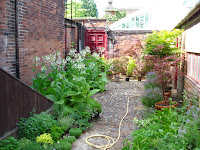
I’ve been at Tatton for the past month. Previous to this I worked at Congleton Park for 21 years –so this is a welcome change for me! Before that, I served an apprenticeship at Stoke on Trent parks. I’m enjoying my time here very much!
Over the past couple of weeks we’ve been doing some winter clearance of areas in the garden. This has included taking down an old fence, to make way for a new fence in the area called ‘Stallion Paddock’.
In front of the Orangery we’ve felled an oak (which was probably over 150 years old), but has needed taking down for safety reasons. We’ve also pruned back the Rhododendrons near the Maze. This is a typical winter task when the ground conditions allow– because the ground is frozen, it allows you to do these heavy jobs, without damaging the ground too much.
We’ve also been taking the Christmas festive decorations out of the Mansion, as it closed to the public at the weekend. A bit strange, as we’ve not even got to Christmas Eve yet! The greenery will be composted for use in the following season. We’ve also made some wreathes using garden greenery, which have been on sale in the Garden Shop.
All the garden team wish everyone a very happy and snowy Christmas! We look forward to blogging more in the New Year.

















.JPG)

